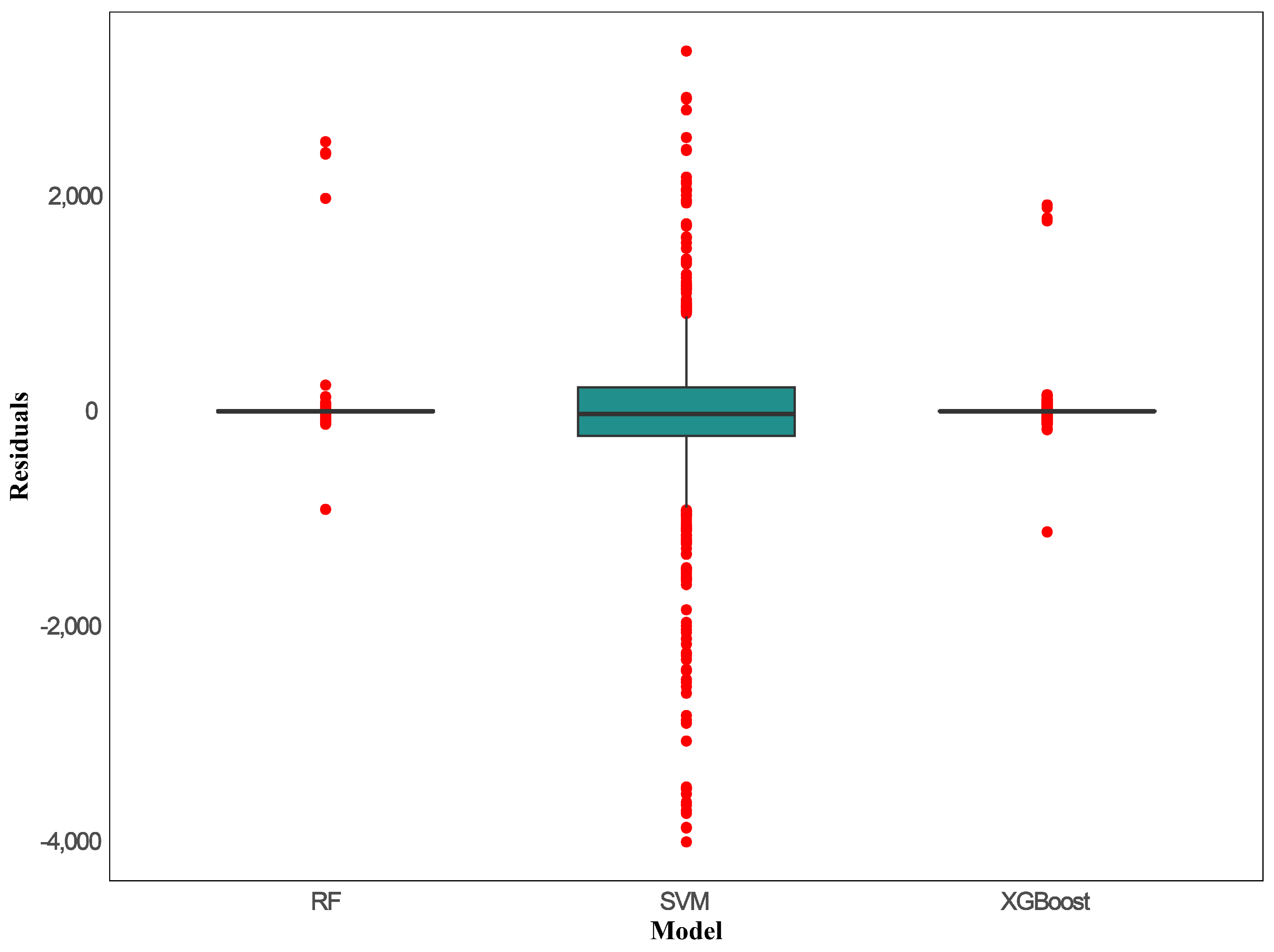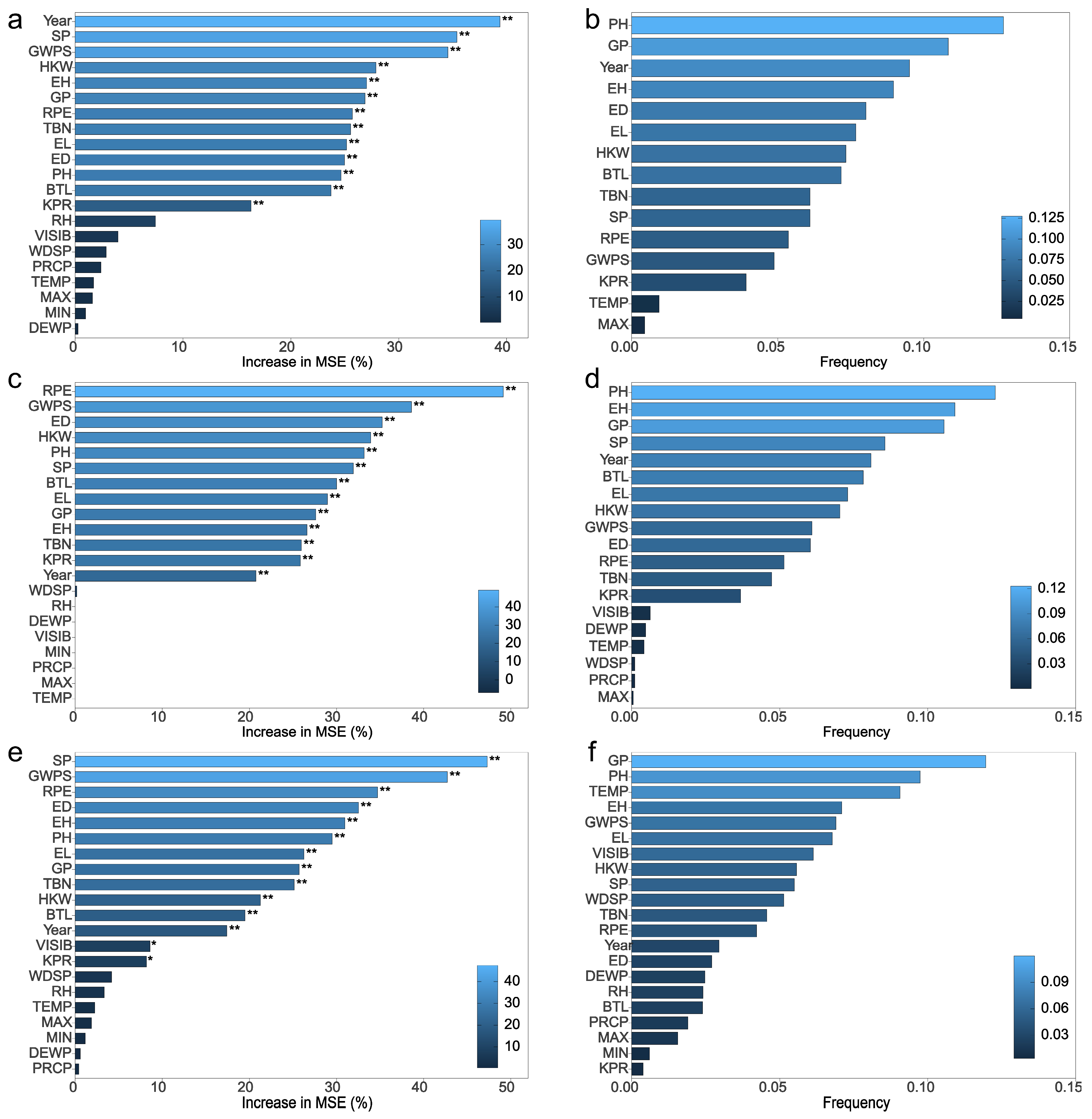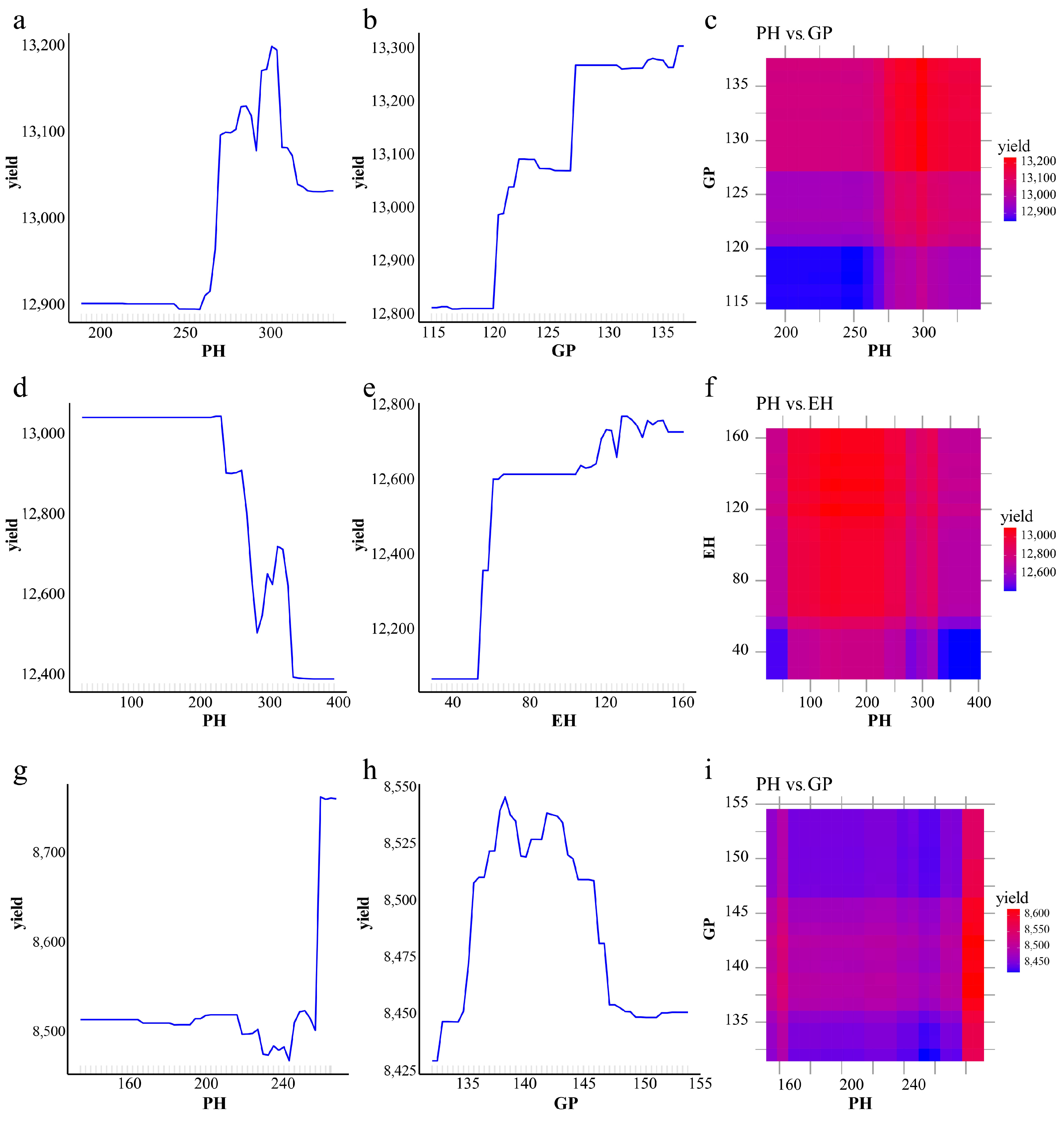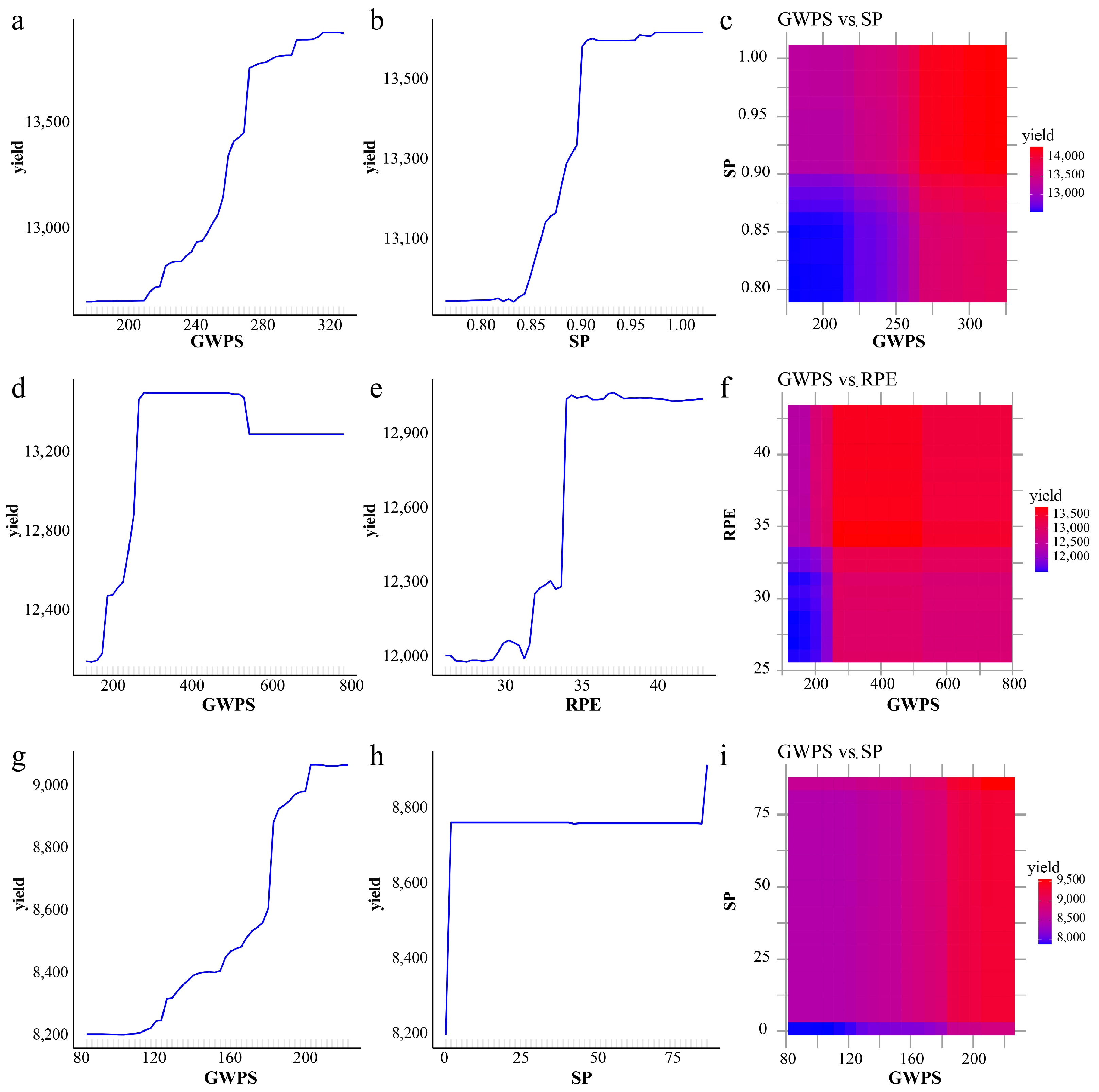Machine-Learning-Based Multi-Site Corn Yield Prediction Integrating Agronomic and Meteorological Data
Abstract
1. Introduction
2. Materials and Methods
2.1. Data Sources
2.2. Experimental Design and Management
2.3. Data Analysis
3. Results
3.1. Correlation Analysis Between Maize’s Agronomic Traits and Yield
3.2. Yield Assessment by Different Models
3.3. The Importance of Predictors in Maize Yield Prediction
4. Discussion
5. Conclusions
Supplementary Materials
Author Contributions
Funding
Data Availability Statement
Acknowledgments
Conflicts of Interest
References
- Ocwa, A.; Harsanyi, E.; Széles, A.; Holb, I.J.; Szabó, S.; Rátonyi, T.; Mohammed, S. A bibliographic review of climate change and fertilization as the main drivers of maize yield: Implications for food security. Agric. Food Secur. 2023, 12, 14. [Google Scholar] [CrossRef]
- Ureta, C.; González, E.J.; Espinosa, A.; Trueba, A.; Piñeyro-Nelson, A.; Álvarez-Buylla, E.R. Maize yield in Mexico under climate change. Agric. Syst. 2020, 177, 102697. [Google Scholar] [CrossRef]
- Wu, J.-Z.; Zhang, J.; Ge, Z.-M.; Xing, L.-W.; Han, S.-Q.; Shen, C.; Kong, F.-T. Impact of climate change on maize yield in China from 1979 to 2016. J. Integr. Agric. 2021, 20, 289–299. [Google Scholar] [CrossRef]
- Jácome-Galarza, L.-R. Multimodal deep learning for crop yield prediction. In Doctoral Symposium on Information and Communication Technologies; Springer International Publishing: Berlin/Heidelberg, Germany, 2022; pp. 106–117. [Google Scholar]
- Yewle, A.D.; Mirzayeva, L.; Karakuş, O. Multi-modal Data Fusion and Deep Ensemble Learning for Accurate Crop Yield Prediction. arXiv 2025, arXiv:2502.06062. [Google Scholar] [CrossRef]
- Danilevicz, M.F.; Bayer, P.E.; Boussaid, F.; Bennamoun, M.; Edwards, D. Maize Yield Prediction at an Early Developmental Stage Using Multispectral Images and Genotype Data for Preliminary Hybrid Selection. Remote Sens. 2021, 13, 3976. [Google Scholar] [CrossRef]
- Kamilaris, A.; Prenafeta-Boldú, F.X. Deep learning in agriculture: A survey. Comput. Electron. Agric. 2018, 147, 70–90. [Google Scholar] [CrossRef]
- Shahhosseini, M.; Hu, G.; Archontoulis, S.V. Forecasting corn yield with machine learning ensembles. Front. Plant Sci. 2020, 11, 1120. [Google Scholar] [CrossRef] [PubMed]
- Asamoah, E.; Heuvelink, G.B.M.; Chairi, I.; Bindraban, P.S.; Logah, V. Random forest machine learning for maize yield and agronomic efficiency prediction in Ghana. Heliyon 2024, 10, e37065. [Google Scholar] [CrossRef]
- Hu, T.; Zhang, X.; Bohrer, G.; Liu, Y.; Zhou, Y.; Martin, J.; Li, Y.; Zhao, K. Crop yield prediction via explainable AI and interpretable machine learning: Dangers of black box models for evaluating climate change impacts on crop yield. Agric. For. Meteorol. 2023, 336, 109458. [Google Scholar] [CrossRef]
- Roy, T.; Das, P.; Jagirdar, R.; Shhabat, M.; Abdullah, M.S.; Kashem, A.; Rahman, R. Prediction of mechanical properties of eco-friendly concrete using machine learning algorithms and partial dependence plot analysis. Smart Constr. Sustain. Cities 2025, 3, 2. [Google Scholar] [CrossRef]
- Croci, M.; Impollonia, G.; Meroni, M.; Amaducci, S. Dynamic Maize Yield Predictions Using Machine Learning on Multi-Source Data. Remote Sens. 2023, 15, 100. [Google Scholar] [CrossRef]
- Baio, F.H.R.; Santana, D.C.; Teodoro, L.P.R.; Oliveira, I.C.d.; Gava, R.; de Oliveira, J.L.G.; Silva Junior, C.A.d.; Teodoro, P.E.; Shiratsuchi, L.S. Maize Yield Prediction with Machine Learning, Spectral Variables and Irrigation Management. Remote Sens. 2023, 15, 79. [Google Scholar] [CrossRef]
- Everingham, Y.; Sexton, J.; Skocaj, D.; Inman-Bamber, G. Accurate prediction of sugarcane yield using a random forest algorithm. Agron. Sustain. Dev. 2016, 36, 27. [Google Scholar] [CrossRef]
- Khanal, S.; Fulton, J.; Klopfenstein, A.; Douridas, N.; Shearer, S. Integration of high resolution remotely sensed data and machine learning techniques for spatial prediction of soil properties and corn yield. Comput. Electron. Agric. 2018, 153, 213–225. [Google Scholar] [CrossRef]
- Jeong, J.H.; Resop, J.P.; Mueller, N.D.; Fleisher, D.H.; Yun, K.; Butler, E.E.; Timlin, D.J.; Shim, K.-M.; Gerber, J.S.; Reddy, V.R. Random forests for global and regional crop yield predictions. PLoS ONE 2016, 11, e0156571. [Google Scholar] [CrossRef]
- Cheng, M.; Penuelas, J.; McCabe, M.F.; Atzberger, C.; Jiao, X.; Wu, W.; Jin, X. Combining multi-indicators with machine-learning algorithms for maize yield early prediction at the county-level in China. Agric. For. Meteorol. 2022, 323, 109057. [Google Scholar] [CrossRef]
- Cai, Y.; Guan, K.; Lobell, D.; Potgieter, A.B.; Wang, S.; Peng, J.; Xu, T.; Asseng, S.; Zhang, Y.; You, L.; et al. Integrating satellite and climate data to predict wheat yield in Australia using machine learning approaches. Agric. For. Meteorol. 2019, 274, 144–159. [Google Scholar] [CrossRef]
- Kang, Y.; Ozdogan, M.; Zhu, X.; Ye, Z.; Hain, C.; Anderson, M. Comparative assessment of environmental variables and machine learning algorithms for maize yield prediction in the US Midwest. Environ. Res. Lett. 2020, 15, 064005. [Google Scholar] [CrossRef]
- Technow, F.; Schrag, T.A.; Schipprack, W.; Bauer, E.; Simianer, H.; Melchinger, A.E. Genome Properties and Prospects of Genomic Prediction of Hybrid Performance in a Breeding Program of Maize. Genetics 2014, 197, 1343–1355. [Google Scholar] [CrossRef]
- Zhang, M.; Cui, Y.; Liu, Y.-H.; Xu, W.; Sze, S.-H.; Murray, S.C.; Xu, S.; Zhang, H.-B. Accurate prediction of maize grain yield using its contributing genes for gene-based breeding. Genomics 2020, 112, 225–236. [Google Scholar] [CrossRef]
- Wang, Y.; Zhang, Z.; Feng, L.; Du, Q.; Runge, T. Combining Multi-Source Data and Machine Learning Approaches to Predict Winter Wheat Yield in the Conterminous United States. Remote Sens. 2020, 12, 1232. [Google Scholar] [CrossRef]
- Meng, L.; Liu, H.L.; Ustin, S.; Zhang, X. Predicting Maize Yield at the Plot Scale of Different Fertilizer Systems by Multi-Source Data and Machine Learning Methods. Remote Sens. 2021, 13, 3760. [Google Scholar] [CrossRef]
- Wu, C.; Luo, J.; Xiao, Y. Multi-omics assists genomic prediction of maize yield with machine learning approaches. Mol. Breed. 2024, 44, 14. [Google Scholar] [CrossRef] [PubMed]
- Zhao, J.; Liu, Z.; Lv, S.; Lin, X.; Li, T.; Yang, X. Changing maize hybrids helps adapt to climate change in Northeast China: Revealed by field experiment and crop modelling. Agric. For. Meteorol. 2023, 342, 109693. [Google Scholar] [CrossRef]
- RColorBrewer, S.; Liaw, M.A. Package ‘Randomforest’; University of California, Berkeley: Berkeley, CA, USA, 2018. [Google Scholar]
- Meyer, D.; Wien, F. Support vector machines. R News 2001, 1, 23–26. [Google Scholar]
- Chen, T.; He, T.; Benesty, M.; Khotilovich, V. Package ‘xgboost’. R Version 2019, 90, 40. [Google Scholar]
- Sparks, A.H.; Hengl, T.; Nelson, A. GSODR: Global summary daily weather data in R. J. Open Source Softw. 2017, 2, 177. [Google Scholar] [CrossRef]
- Azrai, M.; Aqil, M.; Andayani, N.; Efendi, R.; Suarni; Suwardi; Jihad, M.; Zainuddin, B.; Salim; Bahtiar; et al. Optimizing ensembles machine learning, genetic algorithms, and multivariate modeling for enhanced prediction of maize yield and stress tolerance index. Front. Sustain. Food Syst. 2024, 8, 1334421. [Google Scholar] [CrossRef]
- Demir, S.; Şahin, E.K. Liquefaction prediction with robust machine learning algorithms (SVM, RF, and XGBoost) supported by genetic algorithm-based feature selection and parameter optimization from the perspective of data processing. Environ. Earth Sci. 2022, 81, 459. [Google Scholar] [CrossRef]
- Sahin, E.K. Implementation of free and open-source semi-automatic feature engineering tool in landslide susceptibility mapping using the machine-learning algorithms RF, SVM, and XGBoost. Stoch. Environ. Res. Risk Assess. 2023, 37, 1067–1092. [Google Scholar] [CrossRef]
- Ramdani, F.; Furqon, M.T. The simplicity of XGBoost algorithm versus the complexity of Random Forest, Support Vector Machine, and Neural Networks algorithms in urban forest classification. F1000Research 2022, 11, 1069. [Google Scholar] [CrossRef]
- Abbasi, M.; Váz, P.; Silva, J.; Martins, P. Machine Learning Approaches for Predicting Maize Biomass Yield: Leveraging Feature Engineering and Comprehensive Data Integration. Sustainability 2025, 17, 256. [Google Scholar] [CrossRef]
- Chen, S.; Liu, W.; Feng, P.; Ye, T.; Ma, Y.; Zhang, Z. Improving spatial disaggregation of crop yield by incorporating machine learning with multisource data: A case study of Chinese maize yield. Remote Sens. 2022, 14, 2340. [Google Scholar] [CrossRef]
- Babaie Sarijaloo, F.; Porta, M.; Taslimi, B.; Pardalos, P.M. Yield performance estimation of corn hybrids using machine learning algorithms. Artif. Intell. Agric. 2021, 5, 82–89. [Google Scholar] [CrossRef]
- Singh, R.; Biswas, M.; Pal, M. Cloud detection using sentinel 2 imageries: A comparison of XGBoost, RF, SVM, and CNN algorithms. Geocarto Int. 2022, 38, 1–32. [Google Scholar] [CrossRef]
- Sharifi, A. Yield prediction with machine learning algorithms and satellite images. J. Sci. Food Agric. 2021, 101, 891–896. [Google Scholar] [CrossRef]
- Morales, A.; Villalobos, F.J. Using machine learning for crop yield prediction in the past or the future. Front. Plant Sci. 2023, 14, 1128388. [Google Scholar] [CrossRef] [PubMed]
- Meyer, H.; Pebesma, E. Predicting into unknown space? Estimating the area of applicability of spatial prediction models. Methods Ecol. Evol. 2021, 12, 1620–1633. [Google Scholar] [CrossRef]
- Rafiq, C.M.; Rafique, M.; Hussain, A.; Altaf, M. Studies on heritability, correlation and path analysis in maize (Zea mays L.). J. Agric. Res. 2010, 48, 35–38. [Google Scholar]
- Reddy, S.G.M.; Lal, G.M.; Krishna, T.V.; Reddy, Y.V.S.; Sandeep, N. Correlation and path coefficient analysis for grain yield components in maize (Zea mays L.). Int. J. Plant Soil Sci. 2022, 34, 24–36. [Google Scholar] [CrossRef]
- Lu, X.; Zhou, Z.; Yuan, Z.; Zhang, C.; Hao, Z.; Wang, Z.; Li, M.; Zhang, D.; Yong, H.; Han, J. Genetic dissection of the general combining ability of yield-related traits in maize. Front. Plant Sci. 2020, 11, 788. [Google Scholar] [CrossRef] [PubMed]
- Nzuve, F.; Githiri, S.; Mukunya, D.; Gethi, J. Genetic variability and correlation studies of grain yield and related agronomic traits in maize. J. Agric. Sci. 2014, 6, 166. [Google Scholar] [CrossRef]
- Ray, D.K.; Gerber, J.S.; MacDonald, G.K.; West, P.C. Climate variation explains a third of global crop yield variability. Nat. Commun. 2015, 6, 5989. [Google Scholar] [CrossRef]
- Kukal, M.S.; Irmak, S. Climate-Driven Crop Yield and Yield Variability and Climate Change Impacts on the U.S. Great Plains Agricultural Production. Sci. Rep. 2018, 8, 3450. [Google Scholar] [CrossRef]
- Khaki, S.; Wang, L. Crop yield prediction using deep neural networks. Front. Plant Sci. 2019, 10, 621. [Google Scholar] [CrossRef]
- Cairns, J.E.; Hellin, J.; Sonder, K.; Araus, J.L.; MacRobert, J.F.; Thierfelder, C.; Prasanna, B.M. Adapting maize production to climate change in sub-Saharan Africa. Food Secur. 2013, 5, 345–360. [Google Scholar] [CrossRef]
- Li, X.; Takahashi, T.; Suzuki, N.; Kaiser, H.M. The impact of climate change on maize yields in the United States and China. Agric. Syst. 2011, 104, 348–353. [Google Scholar] [CrossRef]
- Shamsuddin, D.; Danilevicz, M.F.; Al-Mamun, H.A.; Bennamoun, M.; Edwards, D. Multimodal Deep Learning Integration of Image, Weather, and Phenotypic Data Under Temporal Effects for Early Prediction of Maize Yield. Remote Sens. 2024, 16, 4043. [Google Scholar] [CrossRef]
- Chen, X.; Feng, L.; Yao, R.; Wu, X.; Sun, J.; Gong, W. Prediction of Maize Yield at the City Level in China Using Multi-Source Data. Remote Sens. 2021, 13, 146. [Google Scholar] [CrossRef]






| GP | PH | EH | TBN | EL | ED | BTL | KPR | RPE | HKW | SP | GWPS | Yield | |
|---|---|---|---|---|---|---|---|---|---|---|---|---|---|
| GP | 1 | ||||||||||||
| PH | −0.51 ** | 1 | |||||||||||
| EH | 0.33 ** | 0.10 * | 1 | ||||||||||
| TBN | −0.16 ** | 0.21 ** | 0.15 ** | 1 | |||||||||
| EL | 0.32 ** | −0.25 ** | 0.06 | −0.10 * | 1 | ||||||||
| ED | −0.15 ** | 0.16 ** | 0.15 ** | 0.02 | −0.06 | 1 | |||||||
| BTL | −0.46 ** | 0.28 ** | −0.15 ** | 0.12 * | −0.18 ** | 0.09 | 1 | ||||||
| KPR | 0.08 | 0.02 | −0.03 | 0.05 | −0.03 | 0.22 ** | −0.11 * | 1 | |||||
| RPE | 0.09 | 0.09 | 0.07 | 0.02 | 0.38 ** | 0.03 | −0.18 ** | 0.03 | 1 | ||||
| HKW | −0.51 ** | 0.47 ** | −0.17 ** | 0.02 | −0.14 ** | 0.27 ** | 0.35 ** | −0.28 ** | −0.06 | 1 | |||
| SP | −0.37 ** | 0.39 ** | −0.16 ** | 0.23 ** | −0.12 * | 0.07 | 0.05 | −0.01 | 0.13 * | 0.37 ** | 1 | ||
| GWPS | −0.51 ** | 0.52 ** | −0.16 ** | 0.21 ** | −0.12 * | 0.28 ** | 0.25 ** | 0.06 | 0.06 | 0.59 ** | 0.43 ** | 1 | |
| Yield | −0.62 ** | 0.63 ** | −0.12 * | 0.12 * | −0.24 ** | 0.34 ** | 0.31 ** | 0.02 | 0.12 * | 0.67 ** | 0.56 ** | 0.68 ** | 1 |
Disclaimer/Publisher’s Note: The statements, opinions and data contained in all publications are solely those of the individual author(s) and contributor(s) and not of MDPI and/or the editor(s). MDPI and/or the editor(s) disclaim responsibility for any injury to people or property resulting from any ideas, methods, instructions or products referred to in the content. |
© 2025 by the authors. Licensee MDPI, Basel, Switzerland. This article is an open access article distributed under the terms and conditions of the Creative Commons Attribution (CC BY) license (https://creativecommons.org/licenses/by/4.0/).
Share and Cite
Ma, C.; Ye, Z.; Zi, Q.; Liu, C. Machine-Learning-Based Multi-Site Corn Yield Prediction Integrating Agronomic and Meteorological Data. Agronomy 2025, 15, 1978. https://doi.org/10.3390/agronomy15081978
Ma C, Ye Z, Zi Q, Liu C. Machine-Learning-Based Multi-Site Corn Yield Prediction Integrating Agronomic and Meteorological Data. Agronomy. 2025; 15(8):1978. https://doi.org/10.3390/agronomy15081978
Chicago/Turabian StyleMa, Chenyu, Zhilan Ye, Qingyan Zi, and Chaorui Liu. 2025. "Machine-Learning-Based Multi-Site Corn Yield Prediction Integrating Agronomic and Meteorological Data" Agronomy 15, no. 8: 1978. https://doi.org/10.3390/agronomy15081978
APA StyleMa, C., Ye, Z., Zi, Q., & Liu, C. (2025). Machine-Learning-Based Multi-Site Corn Yield Prediction Integrating Agronomic and Meteorological Data. Agronomy, 15(8), 1978. https://doi.org/10.3390/agronomy15081978






